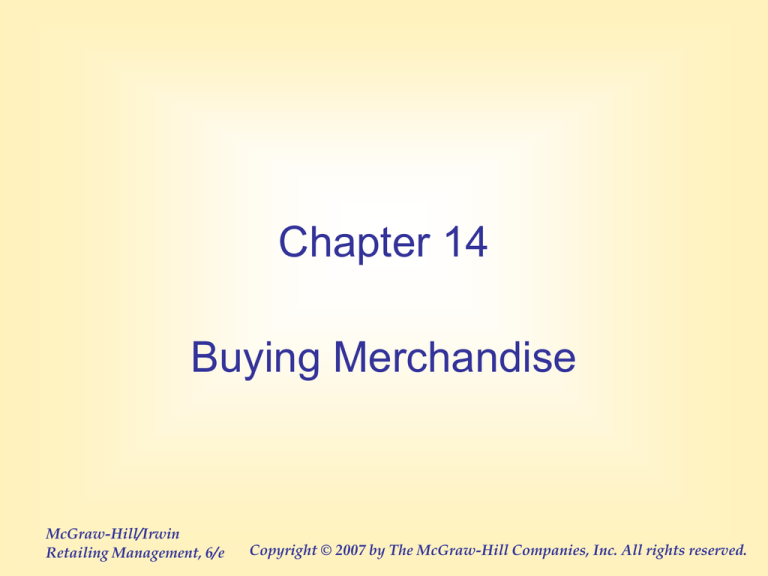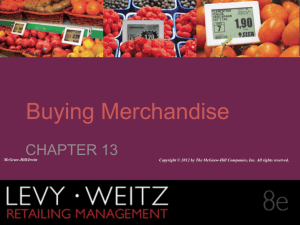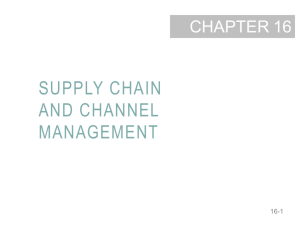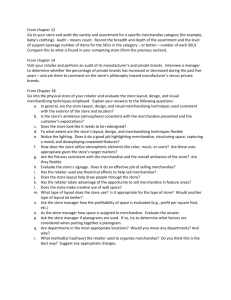
Chapter 14
Buying Merchandise
McGraw-Hill/Irwin
Retailing Management, 6/e
Copyright © 2007 by The McGraw-Hill Companies, Inc. All rights reserved.
14-2
Merchandise Management
Planning
Merchandise
Assortments
Retail
Communication
Mix
Buying
Merchandise
Buying
Systems
Pricing
14-3
Merchandise Branding Strategies
– Designed, produced, and
marketed by a vendor
and sold by many
retailers
• Private-Label (Store)
Brands
– Developed by retailer
and only sold in retailer’s
outlets
The McGraw-Hill Companies, Inc./Jill Braaten, photographer
• Manufacturer (National)
Brands
Spectrum of
National vs. Private Label
14-4
National
Brands
% Store
Brands
The Gap
Macy’s
Wal-Mart
Limited
Target
Home Depot
Marks &
Spencer
IKEA
14-5
Value of Retail Brands
Relative Advantages of
Manufacturer versus Private Brands
Impact on Store
Type of Vendor
Manufacturer
Brands
Private-Label
Brands
Store loyalty
?
+
Store image
+
+
Traffic flow
+
+
Selling and promotional
expenses
+
-
Restrictions
-
+
Differential advantages
-
+
Margins
?
?
14-6
14-7
Private Labels
Advantages
• Unique merchandise
not available at
competitive outlets
• Difficult for customers
to compare price with
competitors
• Higher margins
Disadvantages
• Need to develop
expertise in developing
and promoting brand
• Unable to sell excess
merchandise
• Typically less desirable
for customers
14-8
Manufacturer (National) Labels
• Advantages
• More desired by
customers
• Resell excessive
merchandise
• Don’t need skills and
people to develop and
promote merchandise
Disadvantages
• Lower margins
• Vulnerable to
competitive
pressures
• Limit retailer’s
flexibility
14-9
Buying from Vendors of National Brands
• Helps retailers build their image
• Helps build traffic flow
• Reduces selling and promotional expenses
The McGraw-Hill Companies, Inc./Lars Niki, photographer
Most Recognized Apparel
and Accessory Manufacturer Brands
14-10
Most Recognized Apparel
and Accessory Private Label Brands
14-11
Examples of
Private-Label Brands
14-12
Examples of
Private-Label Brands
14-13
Examples of
Private-Label Brands
14-14
Examples of
Private-Label Brands
14-15
14-16
Going to Market for National Brands
• Wholesale Market Centers
– National Markets (new York), Regional Markets
(Atlanta, Miami)
• Trade Shows
– Frankfurt Book Fair, Las Vegas Consumer
Electronics, Atlanta Sporting Goods
• Internet Exchanges
– Worldwide Retail Exchange
• Meeting Vendors at Your Company
• Diverters, Closeout Specialists, Liquidators, Other
Retailers (Gray Markets, Diversion)
14-17
What do Buyers do at Market?
• Meet with vendors
• Discuss performance of vendor’s merchandise
during the previous season
• Review the vendor’s offering for the coming
season
• May place orders for the coming season
• Sometimes they do not buy at market, but
review merchandise, return to their offices to
discuss with the buying team before negotiating
with vendors
14-18
Negotiating with Vendors
Two-way
communication
designed to reach
an agreement when
two parties have
both shared and
conflicting interests.
Royalty-Free/CORBIS
14-19
Planning Negotiations
• Consider prior history
• Assess current situation
– General market conditions
– Vendor’s position
– Power of vendor
• Set goals
• Be aware of vendor’s goal’s
• Number of people involved
• Select an advantageous place
• Be aware of deadlines
14-20
Issues to Negotiation
Price and gross margin
Additional markup opportunities
Purchase terms
Delivery times and exclusivity
Advertising allowances
Transportation
Steve Cole/Getty Images
14-21
Types of Negotiations
Win
Win
Buyer
Lose
Vendor
Lose
14-22
Win - Lose Negotiation
• Can be good in the short run and
bad in the long-run
• Short-term solution-- person you
are negotiating with can’t lose all
the time
• Might degenerate into LOSE LOSE
14-23
Lose - Lose Negotiation
• Wastes time and energy
• No relationships established
• Objectives not met
14-24
Win - Win Negotiation
Collaboration
Cooperation
Long-term relationship
Doesn’t mean “giving-in”
Enhances vendor trust
Royalty-Free/CORBIS
14-25
Guidelines for Negotiations
• Separate people from problem
• Insist on objective criteria to evaluate
performance
• Invent options for mutual gain
• Let the other party do the talking
• Know how far to go
14-26
Negotiating Tips
•
•
•
•
•
•
Be aware of time
Location -- comfortable
Keep negotiating participants even
Be patient
Let him/her mention a figure
Don’t be afraid to say “no”
14-27
Negotiating Tips
•
•
•
•
•
•
Don’t over negotiate
Don’t assume
Visualize the negotiation
Timing is everything
Always leave the door open
Maintain self-esteem
14-28
Negotiation SUMMARY
(c) Brand X Pictures/PunchStock
Planning is critical
Knowledge is power
A person will only do what is right for him/her
14-29
Functions Provided by Internet Exchanges
• Product Directories
• Use of Reverse Auctions
• Collaboration in Planning – CPRF
Software
• General Information about Trends
14-30
Online Reverse Auctions
• Why reverse?
– Vendors bid for buyer’s business
– Price falls
• One buyer, multiple vendors
14-31
B
S
Reverse Auctions
B
Reverse Auction
B
Traditional Auction
S
S
S
B
14-32
Reverse Auction Process
• Develop specification
• Select potential sources and invite them
to auction
• Bidding for several hours
• Select supplier
14-33
Price Path on Open-Bid Auction
14-34
Strategic (Partnering) Relationships
PhotoLink/Getty Images
Retailer and vendor committed to maintaining
relationships over the long-term and investing in
mutually beneficial opportunities
14-35
Strategic Relationships
Win – Win --Concerned about expanding
the pie, not how to divide the pie
Retailer
vs.
Vendor
14-36
Building Partnering Relationship
Discrete
• One Purchase at a Time
• Short-Term
• Focuses on Price
• Win-Lose Negotiations
• Governed by Contracts
Partnering
• Anticipate Future
• Long-Term
• Considers all Elements
• Win-Win Collaboration
• Governed by Trust
Building Blocks for
Strategic Partnerships
14-37
Mutual Trust
Open Communications
Common Goals
Credible Commitments
•Stockbyte/Punchstock Images
Developing Trust:
Capability or Competence
14-38
Competence
Salespeople demonstrate
competence when they
can show that they know
what they are talking
about.
Requires knowledge of:
The customer
The product
The industry
The competition
(c) Digital Vision/PunchStock
14-39
Stages in Building Strategic Relationships
Awareness
Exploration
Expansion
Commitment
14-40
Vendor Managed Inventory
• Manufacturer access to POS information
• Replenishment automatically triggered
• Enables demand-based view of
replenishment & production planning –
reduce bull whip effect
14-41
VMI—What it Lacked
• Focused on replenishment activity only
• Static-model based (assumed fixed reorder
points to trigger replenishment)
• Often only moved inventory ownership rather
than removing it
• Incomplete information for decision making
• Vendor and retailers use different systems and
data bases
Collaborative Partnering Relationship CPFR
14-42
• Common goals
• A single demand forecast developed
collaboratively
• Collaborative Promotional planning & execution
• A single, shared data source
• Improved inventory management across entire
Supply Chain
• Optimized replenishment strategies with joint
ownership
• Process simplicity creates optimal framework
for success
14-43
Legal and Ethical Issues
• Contractual Disputes
• Resale Price
Maintenance
• Chargebacks
• Commercial Bribery
• Slotting Allowances
• Buybacks
• Counterfeit Merchandise
• Gray Markets and
Diverted
Merchandise
• Exclusive
Territories
• Exclusive Dealing
14-44
Commercial Bribery
• A vendor or its agent offers to give or pay
a retail buyer “something of value” to
influence purchasing decisions.
• A fine line between the social courtesy of
a free lunch and an elaborate free
vacation.
• Rule of thumb - accept only limited
entertainment or token gifts.
14-45
Chargebacks
• A practice used by retailers in which they
deduct money from the amount they owe a
vendor.
• Two Reasons:
– merchandise isn’t selling
– vendor mistakes
• Can be a profit center
– one senior executive at a large department
store chain was told to collect $50 million on
chargebacks
14-46
Slotting Allowances
• Fees paid by a vendor for space in a
retail store.
• Currently aren’t legal.
• Retailers argue that they are a
reasonable method for ensuring that
their valuable space is used efficiently.
• Manufacturers view them as extortion.
• $9 billion or 16% of all new product
introduction costs in grocery industry.
14-47
Slotting Allowances
• Harvard School of Economics
– Give big suppliers competitive advantage over small
suppliers
– Drive small suppliers out of business, then raise
prices
– Anti-competitive – adverse effect of social welfare
• Chicago School of Economics – Free Market
– Improves market efficiency
– Resolve information asymmetry
14-48
Buybacks
• Used to get products into retail stores.
• Two scenarios:
– Retailer allows a vendor to create space for
its goods by “buying back” a competitors
inventory and removing it from a retailer’s
system.
– Retailer forces a vendor to buyback slowmoving merchandise.
14-49
Counterfeit Merchandise
• Goods made and sold without the
permission of the owner of a trademark, a
copyright, or a patented invention that is
legally protected in the country where it is
marketed.
• Major problem is counterfeiting intellectual
property.
14-50
What to do About Counterfeiters
• Trademark,copyright, and/or patent
products in the countries in which they’re
sold.
• US government is engaged in bilateral
and multicultural negotiations and
education to limit counterfeiting. (WTO)
• Take steps to protect yourself.
Gray-Market and
Diverted Merchandise
• Gray- Market Merchandise possesses a valid
U.S. registered trademark and is made by a
foreign manufacturer but is imported into the
United States without permission of the U.S.
trademark owner.
• Not Counterfeit.
• Is legal.
• Diverted Merchandise is similar to graymarket merchandise except there need not be
distribution across international boundaries.
14-51
14-52
Gray-market and Diverted
Merchandise: Taking Sides
• Discount stores argue customers benefit
because it lowers prices.
• Traditional retailers claim important
service after sale will be unavailable
• May hurt the trademark’s image.
Avoiding the
Gray-Market Problem
14-53
• Require customers to
sign a contract
stipulating that they will
not engage in gray
marketing.
• Produce different
versions of products for
different markets.
Steve Cole/Getty Images
14-54
Exclusive Territories
• Granted to retailers so no other retailer in
the territory can sell a particular brand.
• Benefits vendors by assuring them that
“quality” retailers represent their products.
• Assure retailers adequate supply.
• Grants retailers a monopoly.
• Illegal when they restrict competition.
14-55
Exclusive Dealing Agreements
• Occur when a manufacturer or
wholesaler restricts a retailer into
carrying only its products and nothing
from competing vendors.
• Illegal when they restrict competition.
14-56
Tying Contracts
• An agreement that requires the retailer
to take a product it doesn’t necessarily
desire to ensure that it can buy a
product it does desire.
• Illegal when they lessen competition.
• Ok to protect goodwill and quality
reputation of vendor.
14-57
Refusals to Deal
Suppliers and retailers
have the right to deal
or refuse to deal with
anyone they choose.
Except when it
lessens competition.
Kent Knudson/PhotoLink/Getty Images
14-58
Ethical Issues
• Should a retailer sell merchandise that it suspect was
made using child labor?
• Should a retailer advertise its prices are the lowest
available in the market even though some items are
not?
• Should a retail buyer accept an expensive gift from a
vendor?
• Should retail salespeople to use a high-pressure sales
approach when they know the product is the best for
the customer’s needs?
• Should a retailer give preference to minorities when
making promotion decisions?
• Should a retailer treat some customers better than
other customers?
14-59
Guidelines
1. Would I be embarrassed if a customer found out about this
behavior?
2. Would my supervisor disapprove of this behavior?
3. Would most co-workers feel that this behavior is unusual?
4. Am I about to do this because I think I can get away with it?
5. Would I be upset if a company did this to me?
6. Would my family or friends think less of me if I told them about
engaging in this activity?
7. Am I concerned about the possible consequences of this
behavior?
8. Would I be upset if this behavior or activity were publicized in
a newspaper article?
9. Would society be worse off if everyone engaged in this
behavior or activity?







